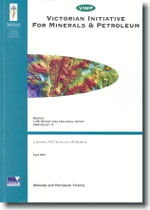VIMP Report 72 - Bendigo 1:250 000 map area geological report
 |
| |||||||||||||||||||||||||||||
Product description:Download The downloadable version of this report is supplied in PDF format. Abstract This report gives an overview of the geology of the area in central Victoria covered by the BENDIGO 1:250 000 map (SJ 55–1). It contains a summary of the previous work used to compile the geology map, and gives a brief regional account of the physiography, geological history and landscape evolution, stratigraphy and structural and economic geology. The geological and geophysical characteristics of Palaeozoic and Cainozoic rock units are described, with particular emphasis on the recently revised lithostratigraphic subdivisions of the Cambrian and Silurian–Devonian rocks, and depositional models are suggested for each. Geological and geophysical information are compiled and interpreted to provide a geological history which highlights a new understanding of the structural evolution of this region. A comprehensive list of references is included, and numerous photographs and line drawings accompany the text. The surface geology incorporates Palaeozoic rocks of the Central Victorian Highlands and Cainozoic sediments of the Riverine Plain of the Murray Basin. The oldest exposed rocks are the Cambrian submarine lavas and volcaniclastics and oceanic pelagic sediments which form the Heathcote greenstone belt. Magnetic data indicate that this belt extends to the north beneath the Riverine Plain, and that a belt of similar rocks trends southeast across northeastern BENDIGO. A thick package of Ordovician deep marine quartz-rich turbidites extends across western BENDIGO, and subsurface in northeastern BENDIGO. These rocks are lithologically monotonous and therefore are subdivided according to their rich graptolite fauna. Near Bendigo they are also subdivided into several geophysical domains according to changes in the density and strike of subsurface dykes. The Silurian–Devonian marine sedimentary rocks of eastern BENDIGO have been grouped according to their lithology. Here, mud dominated packages are separated by mappable, coarser grained clastic turbidite sequences. The surface geology suggests a complex structural history which began with the formation of east verging folds and major thrusts in the Cambrian–Ordovician sequence during a Late Ordovician–Early Silurian deformation. Following the deposition of the Silurian–Devonian sediments, the Middle Devonian Tabberabberan Deformation created new folds and thrusts, and reactivated many of the earlier formed structures. During the Late Devonian, granites intruded and metamorphosed the Palaeozoic rocks. In the text, references are given to excursion guides which show the best exposures of the main Palaeozoic rocks and structures. The post-Palaeozoic sediments reflect a history of successive periods of uplift and erosion related to the tectonic effects of the breakup of the Gondwana landmass, and the development of a seafloor spreading centre between Australia and Antarctica. These sediments record the interaction of regional tectonics with global eustatic and climatic oscillations during the formation of the Central Victorian Highlands and the development and subsequent infilling of the Murray Basin. Gold is undoubtedly the most important of the various types of mineral deposits which occur in this region. Records indicate that about 800 000 kg of gold has been extracted from twenty-five major goldfields, with about 696 000 kg produced from the Bendigo goldfield alone. In places gold is accompanied by significant deposits of antimony. Other metallic minerals in BENDIGO include bismuth, copper, zinc, lead, nickel, silver, tungsten and molybdenum. Important nonmetallic commodities include gravel; sand; clay (especially kaolin); granite (mostly as dimension stone); and gypsum. Extensive subsurface subeconomic deposits of brown coal are present in northern BENDIGO. Bibliographic reference Edwards, J., Slater, K.R., & McHaffie, I.W., 2001. Bendigo 1:250 000 map area geological report. Victorian Initiative for Minerals and Petroleum Report 72. Department of Natural Resources and Environment. Related products:
| ||||||||||||||||||||||||||||||



